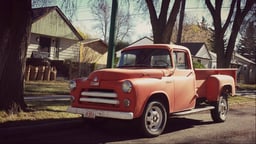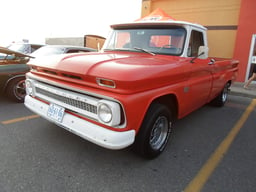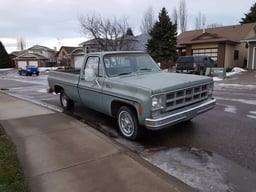Pickup truck
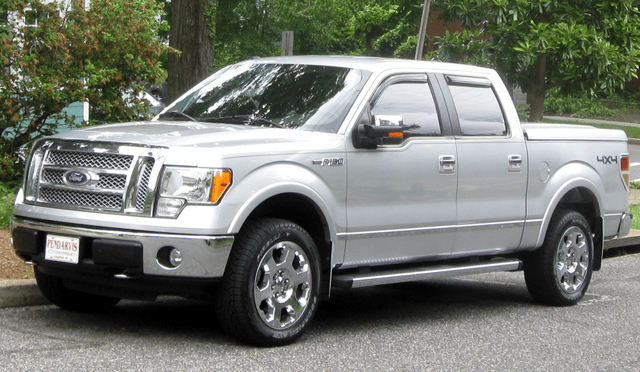
Pickup truck
A pickup truck is a light-duty truck having an enclosed cab and an open cargo area with low sides and tailgate.[1] Once a work tool with few creature comforts, in the 1950s consumers began purchasing pickups for lifestyle reasons, and by the 1990s, less than 15% of owners reported use in work as the pickup truck's primary purpose.[2] Today in North America, the pickup is mostly used as a passenger car[3] and accounts for about 18% of total vehicles sold in the United States.[4]
Full-sized pickups and SUVs are an important source of revenue for GM, Ford, and Fiat Chrysler Automobiles, accounting for more than two-thirds of their global pretax earnings, though the vehicles make up just 16% of North American vehicle production. The vehicles have a high profit margin and a high price, with 40% of Ford F-150s selling for US$40,000 or more.[5]
The term pickup is of unknown origin. It was used by Studebaker in 1913 and by the 1930s, "pick-up" (hyphenated) had become the standard term.[6] In Australia and New Zealand, "ute", short for utility vehicle, is used for both pickups and coupé utilities. In South Africa, people of all language groups use the term bakkie, a diminutive of bak, Afrikaans for bowl/container, due to the cargo area's similarities with a bowl.
History
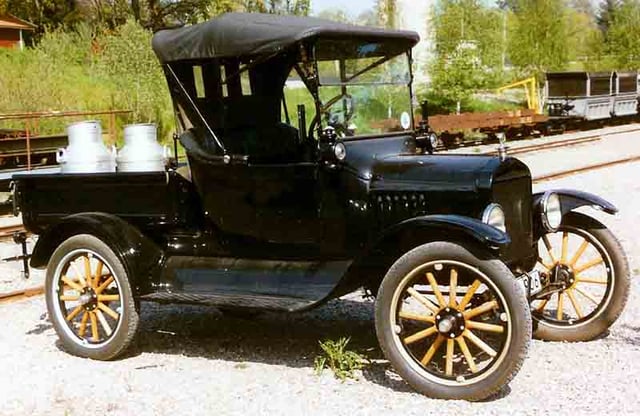
A 1922 Ford Model T pickup
In the early days of automobile manufacturing, vehicles were sold as a chassis only, and third parties added bodies on top.[7] In 1913, the Galion Allsteel Body Company, an early developer of the pickup and dump truck, built and installed hauling boxes on slightly modified Ford Model T chassis,[8] and from 1917 on the Model TT. Seeking part of this market share, Dodge introduced a 3/4-ton pickup with cab and body constructed entirely of wood in 1924.[9] In 1925, Ford followed up with a Model T-based, steel-bodied, half-ton with an adjustable tailgate and heavy-duty rear springs.[10] Billed as the "Ford Model T Runabout with Pickup Body", it sold for US$281; 34,000 were built. In 1928, it was replaced by the Model A which had a closed-cab, safety-glass windshield, roll-up side windows and three-speed transmission. In 1931, Chevrolet produced its first factory-assembled pickup.[11] Ford Australia produced the first Australian "ute" in 1932.[12] During the Second World War, the United States government halted the production of privately owned pickup trucks.[11]
In the 1950s, consumers began purchasing pickups for lifestyle rather than utilitarian reasons.[11] Car-like, smooth-sided, fenderless trucks were introduced, such as the Chevrolet Fleetside, the Chevrolet El Camino, the Dodge Sweptline, and in 1957, Ford's purpose-built Styleside. Pickups began to feature comfort items such as power options and air conditioning.[2] Trucks became more passenger oriented with the introduction of crew cabs in the Toyota Stout[13] and the Hino Briska, was introduced in 1962. Dodge followed with a crew cab in 1963,[14] Ford in 1965, and General Motors in 1973.[15]
In 1963, the U.S. chicken tax directly curtailed the import of the Volkswagen Type 2, distorting the market in favor of American manufacturers.[16] The tariff directly affected any country seeking to bring light trucks into the U.S. and effectively "squeezed smaller Asian truck companies out of the American pickup market."[17] Over the intervening years, Detroit lobbied to protect the light-truck tariff,[16] thereby reducing pressure on Detroit to introduce vehicles that polluted less and that offered increased fuel economy.[16]
The US government's 1973 Corporate Average Fuel Economy (CAFE) policy sets higher fuel-economy requirements for cars than pickups. CAFE led to the replacement of the station wagon by the minivan, the latter being in the truck category, which allowed it compliance with less-strict emissions standards. Eventually, this same idea led to the promotion of sport utility vehicles (SUVs).[18][19] Pickups, unhindered by the emissions controls regulations on cars, began to replace muscle cars as the performance vehicle of choice. The Dodge Warlock appeared in Dodge's "adult toys" line,[2] along with the Macho Power Wagon and Street Van. The gas guzzler tax, which taxed fuel-inefficient cars while exempting pickup trucks, further distorted the market in favor of pickups.
In the 1980s, the compact Mazda B-series, Isuzu Faster, and Mitsubishi Forte appeared. Subsequently, American manufacturers built their own compact pickups for the domestic market: the Ford Ranger, and the Chevrolet S-10. Minivans make inroads into the pickups' market share.[2] In the 1990s, pickups' market share was further eroded by the popularity of SUVs.[2]
International markets
While the Ford F-150 has been the best-selling vehicle in the United States since 1982,[20] the Ford F-150, or indeed any full-sized pickup truck, is a rare sight in Europe, where high fuel prices and very narrow city roads make it difficult to use daily.[21] In America, pickups are favored by a cultural attachment to the style, low fuel prices, and taxes and regulations that distort the market in favor of domestically built trucks.[16] As of 2016, the IRS offers tax breaks for "any vehicle equipped with a cargo area ... of at least six feet in interior length that is not readily accessible from the passenger compartment".[22]
The NOx law and other differing regulations prevent pickups from being imported to Japan, but the Japanese Domestic Market Mitsubishi Triton was available for a limited time. The most-recent pickup truck on sale in Japan is Toyota Hilux.
In China (where it is known by the English loanword as 皮卡车 pí kǎ chē) the Great Wall Wingle is manufactured domestically and exported to Australia.[25] In Thailand pickups manufactured for local sale and export include the Isuzu D-Max and the Mitsubishi Triton. In Latin and South America, the Toyota Hilux, Ford Ranger, VW Amarok, Dodge Ram, Chevrolet S-10, Chevrolet D-20, and Chevrolet Montana are sold.
In South Africa, pickups account for about 17% of the passenger and light commercial vehicle sales, mostly the Toyota Hilux, Ford Ranger, and Isuzu KB (Isuzu D-Max).[26] The Volkswagen Amarok and Nissan Navara are also sold.
Design and features
In the US and Canada, nearly all new pickups are sold with automatic transmissions. The Chevrolet Colorado, Nissan Frontier, and Toyota Tacoma are all available with manual transmissions; Fords are automatic only.[27]
A regular cab has a single row of seats and a single set of doors, one on each side. Extended or super cab pickups add an extra space behind the main seat, sometimes including small seats. The first extended cab truck in the U.S. was called the Club Cab and was introduced by Chrysler in 1973 on Dodge pickup trucks. A crew cab, or double cab, seats five or six and has four full-sized, front-hinged doors. The first crew cab truck in the U.S. was made by International Harvester in 1957, and was later followed by Dodge in 1963, Ford in 1965, and Chevrolet in 1973.
Cab-over or cab forward designs have the cab sitting above the front axle. An early cab-forward, drop-sided pickup was the Volkswagen Transporter, introduced in 1952. This configuration is more common among European and Japanese manufacturers than in North America, since the style allows a longer cargo area for the same overall length. The design was more popular in North America in the 1950s and '60s, examples including the Chevrolet Corvair Rampside and Loadside, Dodge A-100 and A-108, Ford Econoline, and Jeep FC-150 & FC-170.
The cargo bed can vary in size according to whether the vehicle is optimized for cargo utility or passenger comfort. Most have fixed side walls and a hinged tailgate. Cargo beds are normally found in two styles: step-side or fleet-side. A step-side bed has fenders which extend on the outside of the cargo area. A fleet-side bed has wheel-wells inside the bed. The first fleet-sided truck was the 1955 Chevrolet Cameo Carrier. Early trucks had wood-plank beds, which were largely replaced by steel by the 1960s. Some European-style trucks use a drop-sided bed with a flat tray with hinged panels rising up on the sides and the rear.
A pickup with four rear wheels instead of two is, in North America, called a "dually", which is able to carry more weight over the rear axle. Vehicles similar to the pickup include the coupé utility, a car-based pickup, the similar but larger sport utility truck (SUT).
The terms half-ton and three-quarter-ton are remnants from a time when the number referred to the maximum cargo capacity by weight.[28]
The last time Chevrolet and GMC used the Stepside style was on the 2007 Silverado and Sierra Classic models. Ford last used the Flareside style mostly in the 2009 F-150, but it continues on the Raptor variant.
Uses for pickup trucks
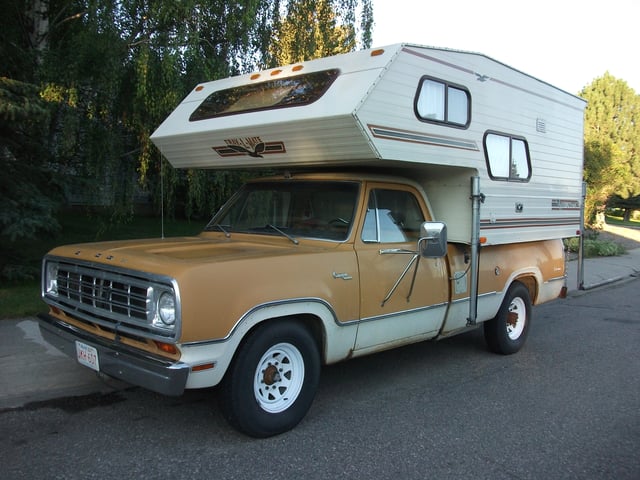
1974 Dodge D200 with camper
In the US and Canada, pickups are used primarily for passenger transport.
Equipping pickup trucks with camper shells provides a small living space for camping. Slide-in truck campers, though, give a pickup truck the amenities of a small motorhome, but still allow the operator the option of removal and independent use of the vehicle.[29]
Modified pickups can be used as improvised, unarmoured combat vehicles called technicals.
Pickup trucks are used to carry passengers in parts of Africa and Southeast Asia. In Thailand, most songthaews are converted pickup trucks and flatbed trucks. In Haiti, Tap taps are also converted pickup trucks.
See also
List of pickup trucks in current production
Pickup truck racing, a form of auto racing using modified versions of pickups mostly on oval tracks
Rolling coal: some pickups are modified to produce more diesel exhaust.[30] Modifications may cost from $2,000 to $5,000.[31][32]



